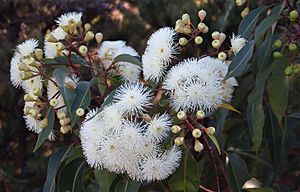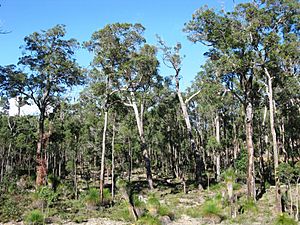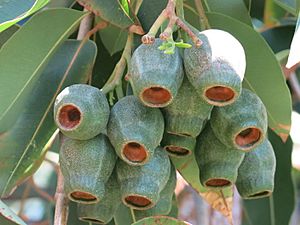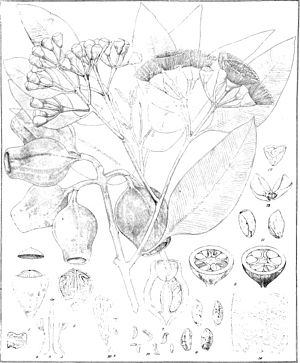Marri facts for kids
Quick facts for kids Marri |
|
|---|---|
 |
|
| Corymbia calophylla, near Cataby | |
| Scientific classification | |
| Genus: |
Corymbia
|
| Species: |
calophylla
|
Corymbia calophylla is a very large and common tree found in the southwest part of Australia. It is often called marri, a name that comes from the Noongar language. People prefer to use "marri" instead of "red gum" because "red gum" can be confusing as other trees also have that name.
When the marri tree gets hurt, it leaks a red, sticky liquid that looks like blood. This liquid is called kino. People can collect this kino and use it for different things. Marri trees grow very fast and can become huge. They often grow in areas where the land has been disturbed, sometimes growing faster than other plants. Their big green leaves create lots of shade, which helps many animals find a comfortable home. The rough bark on their trunks and branches also provides shelter for many different creatures.
Contents
What Does Marri Look Like?
The marri tree is usually very tall, often growing up to 40 meters (about 130 feet) high. Some can even reach over 60 meters (nearly 200 feet)! The biggest known marri tree is 71 meters (233 feet) tall. Its trunk can be as wide as 2 meters (6.5 feet), and its branches are thick and spread out.
The bark of the marri tree is rough and has a pattern like a checkerboard. It's usually grey-brown to red-brown and covers the whole trunk and branches. The adult leaves are thick and shiny green on both sides. They are shaped like a spear or an egg, about 9 to 14 cm (3.5 to 5.5 inches) long.
Marri trees bloom between December and May. They produce beautiful white or sometimes pink flowers. After the flowers, large fruits, often called "gumnuts," grow. These gumnuts can stay on the tree for a year or more. They are oval or urn-shaped, about 30 to 50 mm (1.2 to 2 inches) long.
The big gumnuts contain large seeds. These seeds are a very important food source for native birds like cockatoos. Marri trees grow easily from their seeds. The large buds and fruits of the marri tree are very special among bloodwood trees. In Western Australia, people often call these large fruits "honky nuts."
How Marri Got Its Name
The marri tree was first called Eucalyptus calophylla in 1831. The name calophylla means "beautiful leaf" in Greek. This name was chosen because the leaves are very pretty and their veins look like those of a tropical plant called Calophyllum.
Later, in 1995, scientists Ken Hill and Lawrie Johnson changed the tree's scientific name to Corymbia calophylla. This happened because they realized that marri was more closely related to a group of trees called "bloodwoods" than to other eucalyptus trees. So, it got its own new genus, Corymbia.
Marri is related to another tree called Corymbia ficifolia, which has red flowers and grows in the same area. The marri tree is usually taller (up to 50 meters or 164 feet) and has much bigger buds and fruits. Its flowers are usually white, but sometimes pink, unlike the red flowers of C. ficifolia.
For a long time, people called marri "red gum" because of the red sap that often flows from its trunk. But other trees were also called "red gum," which caused confusion. To make things clearer, the Forestry Department in Western Australia decided in the 1920s to officially use the name marri. The Noongar people have many names for the tree, including gardan, kurrden, mahree, marri, nandap, or ngora.
Where Marri Trees Grow

Marri trees are found all over the Southwest region of Western Australia. They grow from north of Geraldton down to Cape Riche, and inland past Narrogin. This shows how well they can adapt to different environments, from the Swan Coastal Plain to the Darling Scarp.
Marri trees can grow in many types of soil, even poor ones. However, very healthy marri trees often mean the soil is good for farming. You can find them on flat lands, hills, near wetlands, and next to rivers. They grow in various soils, including clay, sandy clays, gravel, and sandy soils over limestone or granite.
Over time, the number of marri trees has changed. Things like city growth, clearing land for farms, and changes in how fires are managed have affected their population.
Marri's Role in Nature
Marri is a very common tree, but its numbers have changed a lot because of how land has been used. When the soil and climate are right, marri trees are a very important part of the environment. They have close relationships with many other plant and animal species.
The fruits and seeds of the marri tree are a main food source for birds like the long-billed black cockatoo and the red-capped parrot. These birds use their beaks and feet to get the seeds out of the hard gumnuts. The marks they leave on the nuts can even tell us which type of bird was eating them!
Marri trees often grow alongside other plants. For example, in jarrah-marri woodlands, marri trees grow tall with Eucalyptus marginata trees. They also grow with smaller trees like Corymbia haematoxylon. Marri can even take over areas where other eucalyptus trees used to grow.
The woodlands where marri trees are common, especially with Xanthorrhoea preissii (grass trees), are now considered a critically endangered ecological community. This means they are very important but have become rare.
How People Use Marri
Marri trees were very important in Noongar culture, and their uses were shared with European settlers in Southwest Australia.
The red sap, or mayat, that oozes from the tree has special qualities. It contains tannins, which are like natural antiseptics. Noongar people would crush the mayat into a powder and put it on open wounds to stop bleeding. They also mixed it with water to make a mouthwash or a disinfectant. Sometimes, they mixed it with clay and water to make a medicinal drink for stomach problems. This sap was also used to tan kangaroo skins for cloaks and bags. Early European settlers also used the kino for tanning animal skins.
The wood of the marri tree is used to make various items. Noongar people made doarks (sticks for knocking off grass tree tops), nys kitjs (spears), and nys wannas (digging sticks). Today, marri timber is becoming popular for making modern household furniture. The wood is a beautiful honey color and has unique patterns. However, it's not often used in big construction projects because the wood can have natural flaws. Trees that grow in certain soils have less of the red sap in their wood, making them more useful for different things.
The flowers of the marri tree are a source of sweet syrup. You can suck the syrup directly from the flower or dip the flowers in water to make a sweet drink. This drink was called numbit by the Noongar people. The blossoms also attract bees, and honey can be found in the hollows of the tree branches. Many birds also build their nests in the hollows of marri trees, where their eggs can be found.
The large, unique fruits of the marri tree are famous in children's stories. The author May Gibbs, who grew up in Western Australia, was likely inspired by them for her 'Gumnut babies' stories. The Noongar poet Jack Davis also wrote about the importance of marri in his poem 'The Red Gum and I'.
Growing Marri Trees
You can grow marri trees by planting seeds directly in the ground or by growing them in pots first. The species is sold commercially as seeds or young plants for landscaping in towns and cities in Southwest Australia. It's a popular choice for public parks and as a street tree.
One of the first marri trees grown outside Australia was at Kew Gardens in England. It grew from seeds collected in 1802. While marri can grow in tropical places, it doesn't do well in cold, frosty areas.
Images for kids
See also
 In Spanish: Corymbia calophylla para niños
In Spanish: Corymbia calophylla para niños






